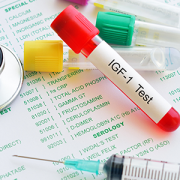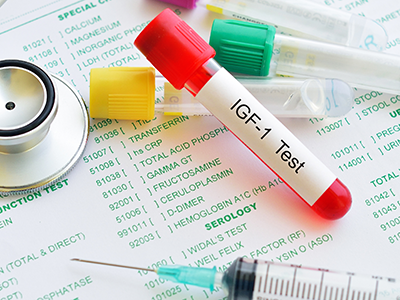
Andrew Dauber, M.D., hosts an AMA chat with Reddit’s science community and offers feedback about height, growth disorders and pediatric endocrinology.
Andrew Dauber, M.D., MMSc., the division chief of endocrinology at Children’s National, spoke about epigenetics – how genes are expressed – and about all things related to pediatric endocrinology in a recent Ask Me Anything (AMA) chat with Reddit’s science community.
We’ve selected highlights from several questions Dr. Dauber received. You can view the full AMA discussion on Reddit.
Q1: What will the future of type 1 diabetes treatment look like?
As a pediatric endocrinologist, Dr. Dauber sees a lot of patients with type 1 diabetes. He predicts technology will pave the way for advancements with continuous glucose monitoring and encourage a ‘real-time’ interaction between patients and providers:
“I anticipate that within a few years, everyone will have access to continuous glucose monitoring technology and that these will be seamlessly connected to insulin pumps or artificial pancreas technologies,” types Dr. Dauber in response to the first AMA question. “I also think there will be more virtual interaction between medical providers and patients with doctors and nurses reviewing blood sugar data in the cloud.”
Q2: What height range is considered normal for a growing child? What is the difference between short stature and a height problem?
The Centers for Disease Control and Prevention has a growth chart, which shows ‘normal’ ranges, based on statistical definitions of height in the general population.
“The truth is that I know plenty of people who have heights below the ‘normal’ population, and they don’t think they have a problem at all,” says Dr. Dauber. “From a genetics point of view, the question can be reframed: When do we call a genetic variant a ‘mutation’ versus a rare variant in the population? For example: If there is a genetic change that 1 in a 1,000 people have that causes you to be 2 inches shorter – is that a problem? Is that a disease?”
“From a clinical perspective, I tend to have a discussion with my patients and their families and ask them how their stature is affecting their lives and whether changing that would really make a meaningful difference,” adds Dr. Dauber. “I believe that this is a very personal decision but people need to be realistic about expected outcomes.”
Q3: What are your favorite case studies about atypical growth or height patterns?
Dr. Dauber references two case studies about growth and puberty:
The growth case study refers to the PAPPA2 gene, which was particularly meaningful for Dr. Dauber since he got to know the family and was able to provide answers to a previously undiagnosed medical mystery about short stature. This research is also opening future studies and analysis about the regulation of IGF-1 bioavailability.
The puberty case study looks at the opposite end of growth and development: precocious puberty. In this case an inherited MKRN3 gene mutation resulted in new insight about the regulation of pubertal timing: Deficiency of MKRN3 caused central precocious puberty in humans. Girls who had inherited the mutated genes from their father (an imprint gene) started to develop breasts before age 6. The results were published in The New England Journal of Medicine.
Q4: What are the differences with consistent and inconsistent growth disorders? Could one arm or leg experience accelerated or stunted growth?
“Most genetic disorders that affect growth will have a uniform effect throughout the body as they are likely to affect all aspects of the skeleton,” says Dr. Dauber. “That being said, there are some notable exceptions such as Russell-Silver syndrome which presents with body asymmetry. There are also somatic mutations (mutations which are just present in some cells in the body) that can lead to segmental areas of overgrowth leading to asymmetry.”
Q5: Can you predict height and growth by looking at genetic factors? What are your thoughts about polygenic risk scores?
“Polygenic risk scores will probably play more of a role in the future to help determine risk of a certain disease,” says Dr. Dauber. “Right now, for most conditions, the risk score does not explain a substantial enough fraction of the variation to help with prediction.”
Dr. Dauber discusses how this works for height, a highly hereditable trait, in The Journal for Clinical Endocrinology and Metabolism. In the review, Dr. Dauber and the study co-authors note that individuals with extreme heights are more likely to have abnormal stature as a result of a severe mutation that causes a growth disorder. For these individuals, whole exome sequencing may reveal gene mutations.
However, the study authors note that for now, the role of these technologies in individuals with extreme stature but without any syndromic features has not been rigorously and systematically explored. (Dr. Dauber and a team of endocrinologists from leading children’s hospitals are currently using electronic health records to study and track these types of genetic clues over time.)
Q6: The general public is excited about genetics and ongoing research, especially with consumer applications – such as genetic tests, including 23andMe. What misconceptions about genetics do people have? What ethical concerns do geneticists share right now?
“Many people think that genetics is completely deterministic,” says Dr. Dauber. “In reality, most genetic variants influence a person’s predisposition toward a trait or disease but don’t actually determine the outcome. Also, the genetic sequence itself is just the first step. Epigenetics, gene regulation, and gene-environment interactions are all important and we are just scratching the surface of understanding these areas.”
“I think that people engaged in genetics research are very interested in the ethical questions,” adds Dr. Dauber. “The problem is that technology is advancing at such a rapid pace, that often consumers are using technologies in ways that we haven’t yet had time to figure out the ethics for. The medical community is often playing catch up.”
Q7: Aside from using gene modifications to cure diseases, where or when should we draw the line in terms of enhancement?
“I think genetic modification for enhancement is a very dangerous slippery slope that we should avoid,” says Dr. Dauber. “We really don’t know the full effect of many genes and by enhancing them, we could be causing lots of problems that we can’t anticipate. There is a reason that evolution is a slow process that happens over millions of years. I think we need to start with the most devastating diseases and try to cure those first.”
Q8: Would it be ethical to use CRISPR on the genes for short stature to produce tall offspring if the risks are sufficiently small? This would be similar to what Dr. He did, but without the ethical violations.
“This is a fascinating question and it will become more of an issue over time,” says Dr. Dauber. “Where do we draw the line between fixing, preventing disease and enhancing physical function? Personally, I think using genome editing to promote height is a terrible idea. Our current perception that taller height is more desirable is a social construct and varies by culture. This idea also changes over time.”
Q9: Overall, how does this fit into meeting unmet medical needs?
“I would be very wary about trying to design our children’s physical features,” Dr. Dauber notes. “We need to figure out as a society what diseases are sufficiently problematic that we feel comfortable trying to eliminate them via genome editing.”
Q10: How many genes control acromegaly? Is it possible (in theory) to Top of Formselect them just to gain the positive effects of gigantism without the health risks?
Dr. Dauber explains that acromegaly, a condition often referred to as gigantism, is caused by a growth hormone-producing tumor. There are a few genes known to cause these tumors, including the AIP, and there was recently a genetic cause of X-linked gigantism, which was published in The New England Journal of Medicine.
“This basic idea is a good one,” notes Dr. Dauber. “We can find genes that when mutated can cause tall stature – and then try to manipulate those pathways. A great example is the NPR2 gene, which when mutated can cause short or tall stature. This pathway is being targeted for therapeutics related to achondroplasia.”
The National Institutes of Health (NIH) refers to achondroplasia as ‘short-limbed dwarfism,’ which results in an average-sized trunk with short limbs, especially arms and legs, due to a lack of cartilage turning into bone. The average height of an adult male with achondroplasia is 4 feet, 4 inches, while the average height of adult females with achondroplasia is less than 4 feet, 1 inch. In this case, manipulating growth pathways may help alleviate health problems associated with achondroplasia: lack of mobility or range of motion, an enlarged head, apnea, ear infections and spinal stenosis, or a compression or pinching of the spinal cord.
Q11: Give us a history lesson. Why are there variations of height within populations, such as Asia and Latin America?
“The average height in a population is due to the influence of literally thousands of common genetic variants,” says Dr. Dauber. “These population differences have evolved over thousands of years due to a combination of migration and selection. There is a well-known difference in the genetic makeup of various populations which likely underlies the differences across the globe. There are even differences within Europe.”
Q12: Are there examples of pseudoscience or theories about growth, such as recommendations to eat a certain food instead of taking growth hormones to correct for a growth disorder, which runs contrary to scientific evidence, that drive you crazy?
“I don’t really get bothered by crazy theories, but it is upsetting when patients and their families get swindled into spending their money on therapies that aren’t truly effective,” says Dr. Dauber. “People ask me all the time if a certain food or exercise can make their child taller. The bottom line is that in a well-nourished (and healthy) child, there is no magical food that is going to make them tall.”
Q13: According to almost every theory of how life evolved on Earth, from religion to evolution, we all have one common ancestor. In theory doesn’t that make us all cousins?
“Yes, just very distant ones,” says Dr. Dauber. “People always point out the vast number of differences between races but in fact we are all more than 99.9 percent identical on a genetic level.”
Stay on top of the latest pediatric endocrinology news by following @EndoDocDauber and @ChildrensHealth on Twitter.









